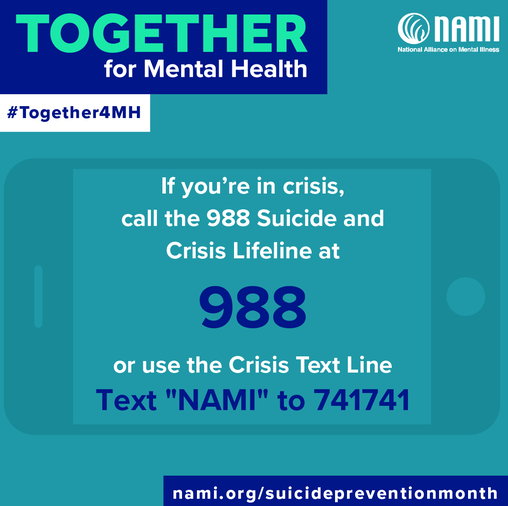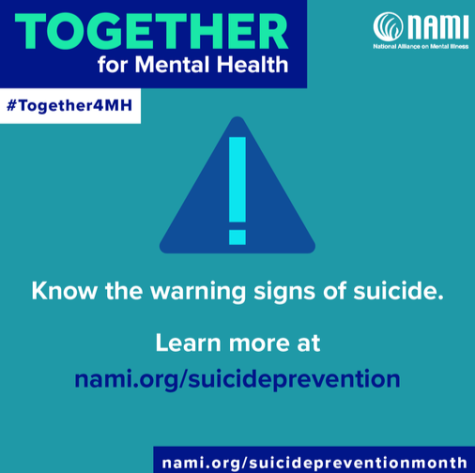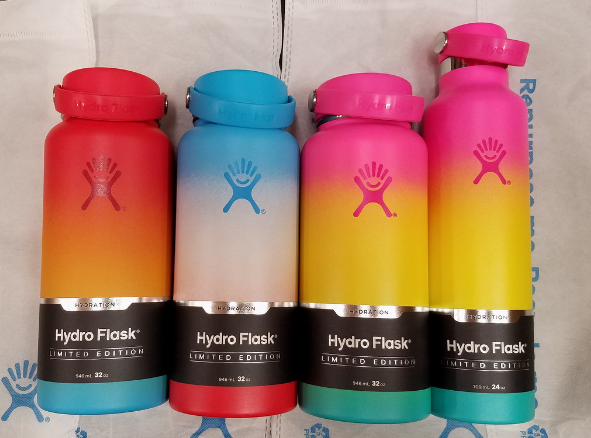Suicide Prevention
The month of September is suicide prevention awareness month.

nami.org/suicidepreventionmonth
The national Suicide and Crisis Lifeline is 988.
September 20, 2022
September is a month recognized by many things. It is the star month of songs like “Wake Me Up When September Ends” by Green Day and “September” by Earth, Wind, and Fire. It’s also the start of fall and the precursor to the holiday season.
However, there is one very significant yet under-recognized aspect of this iconic month – it’s suicide prevention awareness month.
Now, when one thinks of suicide prevention, the thought of awkward talks with their parents, school assemblies, or PSAs about the importance of mental health probably come to mind. Although these conversations can be uncomfortable in the moment, they are really essential to saving lives.
According to the Center for Disease Control (CDC), suicide is the second leading cause of death amongst youth ages 10-34.
Similarly, the National Alliance on Mental Illness (NAMI) has found that 90% of people who commit suicide may have experienced symptoms of a mental health condition.
These statistics demonstrate that suicide is prevelent in our modern society, but in many cases it is preventable; “uncomfortable” talks about suicide and mental health with others is crucial to help stop the stigma of reaching out for help, especially for select groups of people.
For instance, 79% of all people who die by suicide are men, which can be attributed to the shame associated with men receiving help.
Toxic masculinity in the modern world has escalated to a point where many men believe if they reach out for help, they are seen as weaker than men who struggle alone. This, however, is a dangerous lie.
This viewpoint is also usually strengthened in the young-adult age demographic where cliques can influence and amplify these sorts of feelings.
It isn’t just men who are disproportionately affected by suicide, though.
In fact, 45% of LGBTQ youth have serious thoughts of suicide – with lesbian, gay, and bisexual youth being 4 times more likely to attempt suicide than straight youth.
Every 45 seconds, there is at least one suicide attempt by an LGBTQ youth.
Furthermore, transgender adults are nine times more likely to attempt suicide than the general public.
Similar to men struggling with feeling weak for getting help, LGBTQ youth could feel unwelcome getting help due to the polarization of their identities.
Although many are accepting of the community nowadays, the stress of having their identities up for debate – as well as anti-LGBTQ events – combine to create a feeling of isolation for LGBTQ youth.
As stated by the Trevor Project, a suicide prevention organization for LGBTQ teens, “LGBTQ youth are not inherently prone to suicide risk because of their sexual orientation or gender identity, but rather placed at high risk because of how they are mistreated and stigmatized in society.”
Nobody would consider someone weak for seeking help for their physical health, so why is there such a stigma against doing the same for mental health?
It could be due to the fact that groups such as men or LGBTQ youth, those predisposed to higher suicide rates, feel uncomfortable discussing their mental health issues with others due to the stigma surrounding mental health help.
However, the mentality of being hesitant to get help only furthers the stigma in an awful cycle.
There are ways to be there for people who you fear might be at risk to attempt suicide though.
#BeThe1To is a movement that emphasizes a five-step plan that should be followed to help someone with thoughts of suicide.
The first step, “Ask,” consists of simply and directly asking them if they are thinking about suicide. Being direct avoids miscommunications and shows the person that you are thinking of suicide in a way that is non-judgemental.
A part of this step also includes listening and taking the person’s answers to this question very seriously. Listen to their reasons as to why they want to stay alive as opposed to trying to force reasons onto them.
The next step is to “Be There” for the person. If you cannot be physically present, then help the person find others that can be there for them. In this step it is also crucial to follow through on promises to be there.
This step is important because a main factor of suicide risk is isolation combined with a sense of burden. If you show someone with suicidal thoughts that they have people they can rely on and that those people truly and deeply care for them, then these two risk factors are mitigated.
The third step is to “Keep Them Safe”. Once you find out that someone has been considering suicide, it is important to establish where they were in their planning process. If someone had a plan established, it is crucial that you separate them from their planned means of suicide.
It has been proven that if lethal means are made less available, then suicide rates decline.
The second-to-last step is to “Help Them Connect.” This includes building a safety plan if that person were to ever find themselves in a crisis, and connecting them with professionals in their area that could help them with consistently bettering their mental health.
The final step is to “Follow Up” which involves contacting the person even after they have initially expressed their feelings to you and have also received help. This could include a text, call or even sending physical mail – like a postcard.
The final step ensures that the connectedness established in the “Be There” step stays with the person and overall reduces their risk to attempt again.
Now that it has been established how to act when someone is suicidal, it is also important to know how to recognize the signs not just in others, but in one’s self aswell.
While there are a wide range of symptoms, the majority of them involve a change in behavior.
Some symptoms may include: feeling sad, anxious, hopeless, trapped, or like a burden; withdrawing from friends or family, and taking more dangerous risks such as using drugs and alcohol frequently.
On Oakmont’s campus, students can reach out for help through the Wellness Center or by using “See Something, Say Something” to report either yourself or someone else if experiencing these symptoms.
If you are experiencing an active crisis, the Suicide and Crisis Lifeline is avalible as a nationwide phone number at 988.
https://www.cdc.gov/nchs/products/databriefs/db433.htm
https://www.dropbox.com/sh/4kayfla35wcs3p7/AAAqT8TJMjcJQcUbmE-omA3Ta?dl=0
https://www.thetrevorproject.org/resources/article/facts-about-lgbtq-youth-suicide/
https://www.nimh.nih.gov/health/publications/warning-signs-of-suicide













